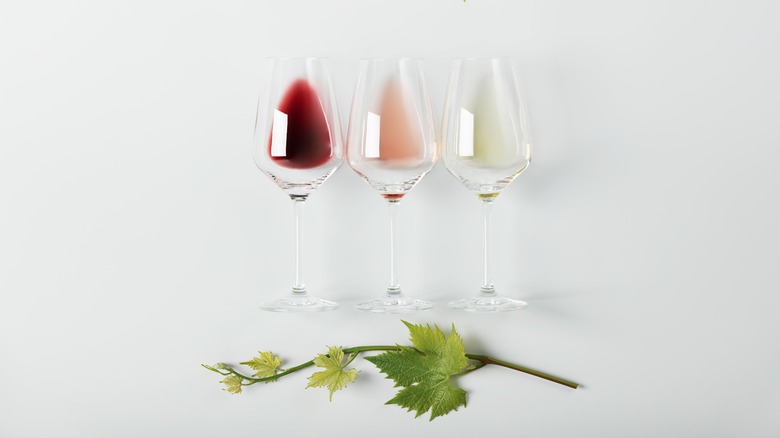What Does It Mean When A Wine Is Dry?
The world of the sommelier is replete with terms that, coming off the tongue of an expert, sound like the absolute peak of taste and class. Use them incorrectly, however, and you might open yourself up to both confusion and embarrassment. You may hear people talk about a wine's "full body" (viscosity), its "nose" (aroma), and "terroir" (the region where it was produced); but, unless you understand these terms, they won't tell you anything useful about the stuff in your class.
Whole dictionaries could be written for the world of wine; but, if you're going to start anywhere, you should start with the most basic: What do we mean when we say a wine is "dry"? "Dry" is one of the most common descriptors for wine, and something you're very likely to hear if you ask a waiter for recommendations. To a novice, it sounds downright nonsense, as how could any liquid possibly be dry? However, wine aficionados do not use "dry" in the literal sense (and thus, they create a great deal of confusion). In short, "dry" in the world of wine is simply an antonym for "sweet." Dry wines are preferable to anyone who dislikes a sugary taste in their drink, and they are generally considered to be the best cooking wines as well. The equivalent term for champagne is the French "brut."
As for what makes a wine sweet or dry, the answer lies in science.
How wine becomes sweet or dry
Wine is a product of chemistry. To make wine, grapes are fermented with yeast, which may be naturally derived from the skin of the grapes and the winery's environs or in the form of cultivated yeast that the wine-producer adds to their grapes. During the fermentation process, the yeast eats the sugar that is naturally present in the grapes, converting it into alcohol. If a winemaker halts the fermentation before the yeast consumes all the available sugar, then they are left with residual sugar in the finished wine, which will make it sweet. Other times, the winemaker allows complete fermentation to take place, which makes for a dry wine.
Technically speaking, a dry wine should not contain more than 1% residual sugar, up to 10 grams per liter of total volume. Dryness exists on a spectrum, though, so you may encounter so-called "off-dry" wines, which can have as much as 35 grams of sugar per liter. Sweet wines are those which exceed 35 grams of sugar per liter, while those exceeding 120 grams are considered "very sweet." Factors affecting the amount of residual sugar include the timing of the fermentation, as well as climatic conditions (cold temperature fermentation leads to sweeter wine), and even the type of yeast that the winemaker uses, as some types consume sugar at a faster rate.
Misconceptions about dry wine
There are two main myths about dry wines that we need to dispel, however, beginning with the idea that dry wines literally dry your mouth out. The skins, seeds, and stems of grapes contain compounds called tannins, which can also be found in a variety of other plant-based foods and beverages — such as coffee, tea, and chocolate — as well as the very wood that wine barrels are made of. Tannins are highly astringent, having a bitter flavor and causing a dry sensation in your mouth. This is due to the fact that tannins bind to salivary proteins, reducing the amount of saliva that gets released in our mouths and generating a feeling of dry friction between oral surfaces (via the National Library of Medicine). Many dry wines happen to be high in tannins, but sommeliers never use "dry" to refer to a sensation in the mouth. Instead, wines with a high tannin content are sometimes referred to as "structured" or "grippy."
Another common misconception is that dry wines have more alcohol by volume than sweet wines, but this is not necessarily so. According to Healthline, alcohol itself can cause your mouth to dry out, so wines with higher alcohol content have a more astringent effect, duping us into the same mistake as tannins: associating dry wine with literal dryness. In actuality, some of the sweetest dessert wines — including sherry and port — are quite strong, having upwards of 15% ABV (alcohol by volume). Thus, they are dry, but not "dry."


